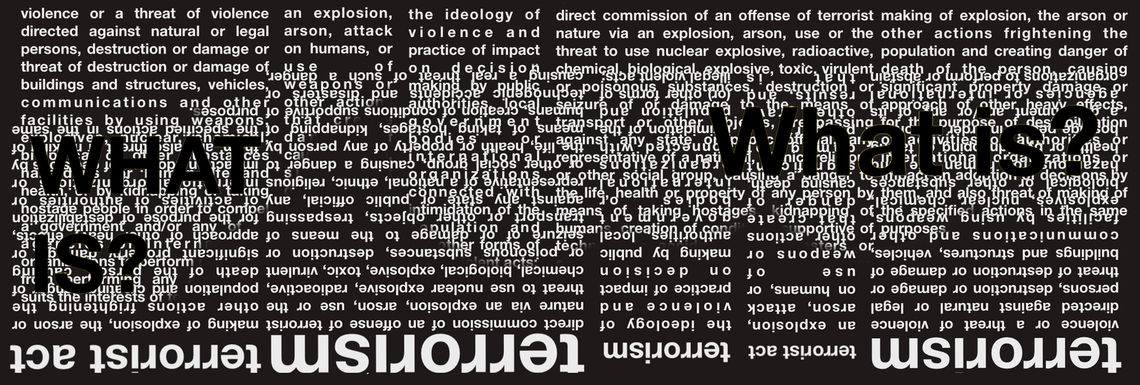Fri Nov 23 2018 · 11 min read
Terrorism and the Definitional Issue in the Armenian Legal System

By Smbat Khachaturian

Since the 9/11 attacks, terrorism has become one of the most widely used, discussed and manipulated terms in political science. After every terrorist incident, politicians, journalists, and law enforcement officials turn to (social) media to unanimously condemn and call for its eradication. Ostensibly everybody agrees it’s a major problem, however when it comes to defining the phenomenon itself, the same people are less reluctant to agree on one definition and reaching consensus becomes a lot more difficult. Paradoxically, since 1963 the international community has elaborated 19 international legal instruments to prevent terrorist acts[1] yet states “fundamentally disagree on its very definition.”[2]
In fact, the definitional task is the most ambiguous component in terrorism studies and the struggle to define it is as hard as the struggle against terrorism itself.[3] Others go even further to conclude that this debate has reached a stalemate and the lack of an acceptable definition made it a “nebulous concept for the international legal system.”[4]
In terrorism studies, there are a large number of overlapping attempts to define terrorism and apparently, almost every scholar considers it a duty to come up with a unique definition. Alex Schmid and Albert Jongman while conducting a comprehensive study on terrorism have documented more than 100 definitions of terrorism and added that in their search for a definition and particulars of the phenomenon “authors have spilled almost as much ink as the actors of terrorism have spilled blood.”[5] In the Armenian academic discourse, terrorism is absolutely neglected, and this is perhaps due to the lack of experts and terrorism studies is not even an academic discipline.
Among terrorism studies scholars there is a broad consensus on the political nature of terrorism, which involves the threat or use of force or violence in which the pursuit of publicity plays a significant role.[6] Political motivation is also central to definitions put forward by many states. The urgency to bring the perpetrators of terrorist acts to justice resulted in a lot of official definitions. Upendra Acharya concluded that lack of a universally accepted definition of terrorism has led to “international lawlessness and unilateral vigilantism.”[7] Accordingly, one wonders if states can effectively tackle terrorism as long as they disagree on its definition.
Perhaps one of the challenges states face is the dilemma of a narrow or broad definition. In the first case, narrowly defined terrorism law may not be appropriate for prosecution, but in the broader definition the law may also delegitimize people’s rights (freedom fighters, self-determination) just as Drake puts it “as a rule, terrorism is the name we give to the violence of people we do not like or support; for the violence of people we do like or support, we find other names.”[8] Therefore, it’s crucial to understand whether states define the phenomenon in a way that would allow them to include certain types of acts and exclude others.
The perception of terrorism is different - for some, it is a criminal act or brutal violence, for others, it’s a divine order or a fight against occupation and brutality; some emphasize the motives and others focus on the operational mode making it difficult to have an acceptable international definition. Hence, a few official definitions of terrorism are considered below in order to highlight the different approaches.
Russian Federal law on counteracting to terrorism [9] states that:
terrorism - the ideology of violence and practice of impact on decision making by public authorities, local government bodies or international organizations connected with intimidation of the population and (or) other forms of illegal violent acts;
act of terrorism - making of explosion, the arson or other actions frightening the population and creating danger of death of the person, causing significant property damage or approach of other heavy effects, for the purpose of destabilization of activities of authorities or international organizations or impact on adoption of decisions by them, and also threat of making of the specified actions in the same purposes.
In the U.S., every agency with a counterterrorism mission uses a different definition of terrorism. [10] In the Code of Federal Regulations terrorism is defined as:
the unlawful use of force and violence against persons or property to intimidate or coerce a government, the civilian population, or any segment thereof, in furtherance of political or social objectives (28 C.F.R. Section 0.85).[11]
Neighboring Georgian law[12] on combating terrorism defines it as:
terrorism - violence or a threat of violence directed against natural or legal persons, destruction or damage or threat of destruction or damage of buildings and structures, vehicles, communications and other facilities by using weapons, explosives, nuclear, chemical, biological or other substances hazardous for human life and health, or by kidnapping or taking hostage people in order to compel a government and/or any of its agencies or international organizations to perform or abstain from performing any action that suits the interests of terrorists;
terrorist act - an explosion, arson, attack on humans, or use of weapons or other actions that create danger of causing death, significant damage of property or other grave results, and that is committed for terrorist purposes; or a threat to commit a terrorist act;
Another interesting case is Armenia - a country which has never experienced any major terrorist attack. Paradoxically, the law on the fight against terrorism doesn’t even define the phenomenon per se, it rather ambiguously describes the act of terrorism as:
direct commission of an offense of terrorist nature via an explosion, arson, use or the threat to use nuclear explosive, radioactive, chemical, biological, explosive, toxic, virulent or poisonous substances, destruction or seizure of or damage to the means of transport or other objects, trespassing against any state or public official, any representative of a national, ethnic, religious or other social group, causing a danger to the life, health or property of any person by means of taking hostages, kidnapping of humans, creation of conditions supportive of technogenic accidents and disasters or causing a real threat of such a danger, spreading threats by any means, human victims, significant damage to the property or other acts entailing dangerous consequences for the public.[13]
Lawmakers in Armenia came up with an arguably obscure definition, broadening the scope of what is considered a terrorist act. The motivation of the perpetrators indicated in the text is rather vague and phrases like ‘an offence of terrorist nature’ or ‘other acts entailing dangerous consequences’ can lead to an inconsistent and unjust application of the law and charge regime opponents over ‘terrorist goals.’ By the same token, the National Strategy on the Fight against Terrorism introduced back in 2012[14] also does not shed light upon the issue. Yet, an important question arises: how is it possible to tackle a phenomenon which is not even defined?
We could probably find the answer in the Criminal Code of the Republic of Armenia, where Article 217 defines this criminal offense as:
Terrorism, is any action, or the threat of action, intended to cause death or serious bodily injury to a civilian or to any other person not taking an active part in the hostilities in a situation of armed conflict, when the purpose of such action, by its nature or context, is to intimidate a population, or to exert pressure on a government body or an international organization or an official to make a decision or to do an act, or to abstain from these; as well as any other action recognized as terrorism by international treaties of the Republic of Armenia except for those specified under Article 218 of this Code, shall be punished with imprisonment for a term of five to ten years, with or without confiscation of property.[15]
Here it’s obvious that the terrorist intent is clearly political and somehow better defined. Simultaneously, in the Armenian legal practice, an approach has been developed, according to which the law-code contradiction should be resolved by prioritizing the Code and this preference is based on Article 9 (6) of the Law "On Legal Acts." However, the first part of the same article sets that “the law regulates the most important, specific and typical and consistent public relations […].”[16] As can be seen, the norm stipulates that all laws must comply with the codes.
This evidence highlights that a law which is supposed to outline the legal and organizational framework for combating terrorism in Armenia and regulate the relations relating to the conduct of this fight lacks the most important thing– the definition of the concept of terrorism itself. In light of this nebulosity, the question of why it is crucial to have a precise understanding of what terrorism means and whether there is a need to have a thorough definition arises. In fact, developing an effective strategy requires agreement on what it is we are dealing with, in other words, we need a clear definition of terrorism. The strength of such an approach is that the definition of terrorism will hamper or diminish the attempts of terrorist organizations to obtain public legitimacy and will erode support among those segments of the population willing to assist them.
Next, on many occasions, Armenia reaffirmed its commitment to combating terrorism in all its forms and manifestations, to consistently cooperate with its international partners and to amend its counter-terrorism legislation in order to address emerging threats, trends, and challenges.[17] Moreover, in light of the recent developments in Syria and the region, as well as U.S. National Security Advisor John Bolton’s visit,[18] one can never exclude Armenia’s possible “involvement” in the ‘War on Terror.’ Thus, the definition of terrorism will be the basis and the operational tool in fulfilling Armenia’s international obligations pursuant to the relevant UN Security Council resolutions and other international documents on counter-terrorism.
Finally, the operational use of the definition of terrorism could motivate terrorist organizations, due to moral and utilitarian considerations, to shift from terrorist activities to alternate courses in order to attain their aims, thus reducing the scope of domestic terrorism.[19]
Hence, the upcoming Armenian parliament needs to draft a new anti-terrorism law, precisely define terrorism and other main concepts used in the law.[20] Moreover, the international legal documents, such as: Council of Europe Convention on the Prevention of Terrorism (2005)[21] (Armenia was signatory and ratified in August 30, 2016, in action since December 1, 2016)[22] and Treaty on Cooperation among the States Members of the Commonwealth of Independent States in Combating Terrorism (1999)[23] (Armenia was signatory and in action since December 28, 2001)[24] may be a source of inspiration and reference. Furthermore, the outdated National Strategy for Combating Terrorism[25] needs to be improved in view of the current geopolitical situation, the high level of terrorist threats in the region, as well as the development and transformation of terrorism itself.


